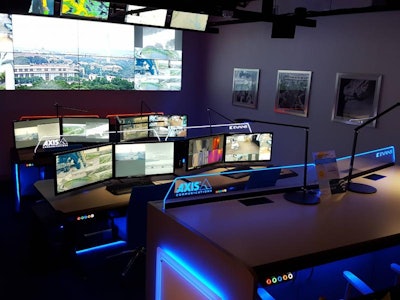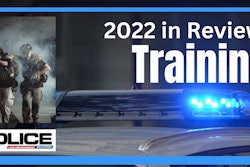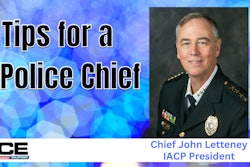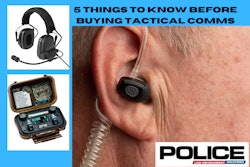 The Axis Experience Center demonstrates how video feeds can be used to drive police response efficiencies.PHOTO: Axis Communications
The Axis Experience Center demonstrates how video feeds can be used to drive police response efficiencies.PHOTO: Axis Communications
Technology used wisely can help police better ensure safety during New Year’s Eve celebrations and other mass gatherings, both in large cities and smaller towns. Kevin Taylor, development manager for the cities vertical segment at Axis Communications, shares how tech can help manage such large events.
Axis Communications’ portfolio is heavily video centric, says Taylor, and the company offers a lot of different IoT (Internet of Things) endpoint solutions. He explains agencies are looking for ways they can use technology as a force multiplier to keep communities safe.
Taylor says in recent years police have faced the challenge of losing a lot of officers through attrition, such as early retirements, and it has become increasingly more difficult to recruit new talent into law enforcement.
“So, they're looking for ways they can leverage technology to make every officer more efficient and more productive, and keep communities safer,” says Taylor. “For us, that is a lot of video in the public right of way, which is often used to drive efficiencies in the emergency response workflow. You also have some leading technologies like automatic license plate recognition (ALPR) and wearable cameras that can both help law enforcement agencies be more proactive and also drive more transparency and trust within the community.”
Scalable to Any City
He points out there are about 19,400 or so towns and cities across the country and the vast number of those are not large metro cities. Many are much smaller communities. Taylor adds that it is important for those cities to be offered solutions that can scale down to a level, not necessarily from a features and capability standpoint, that more modest sized communities can afford to onboard as a solution and have a beginning point.
“I think that scalability term is really important here, especially when we look at the smaller communities. A lot of crime right now is transient; we're seeing criminals that move across jurisdictions,” Taylor says. “So, things like ALPR are able to identify when a vehicle that's already associated to another Part I crime or a vehicle that's already registered as a stolen vehicle enters your community.”
Then police agencies know that vehicle is there and can intercept it in a safe way before the vehicle’s occupants are involved in another potentially violent crime or Part I crime. That use of ALPRs relates to small communities, large communities, and any size city in between.
Partner With Transportation
“One thing that is very common in a lot of communities, whether you're talking about small communities or big communities, is another department within most local governments that tends to consume a lot of video and have a lot of video resources is the transportation agency,” explains Taylor.
He says if you're looking to increase your visibility during large events, partnering with your transportation agency, whether that's a department of transportation or a department of public works, or whoever's managing your roadways and your signal-controlled intersections and the flow of traffic, is a really important internal collaboration opportunity for a law enforcement agency.
Efficient Egress
Taylor says the ability to move people quickly, both into and out of these large gatherings, can help reduce stress in the environment. Get them out quickly and headed home safely and there is less chance tempers can flare and confrontations arise.
“And if that's efficient, and if it's logical, then chances are you'll have fewer traffic accidents, and you don't have to tie up your responders going to traffic accidents instead of dealing with other safety issues of a potential criminal nature. So, partnering with your transportation agency and looking at the flow of people into and out of the event is really important,” he adds.
Also, efficient egress can thin traffic sooner and clear the way for an easier and quicker response for emergency vehicles when needed.
Taylor points out that this process is not just reserved for big cities, nor is it just for New Year’s Eve celebrations. Every small town can implement the same tactics for Fourth of July celebrations, parades, or any other event that draws a large gathering during the year.
Event Headcount
Event organizers and police providing security have always faced the challenge of anticipating crowd size. Now technology can help with those estimates and allow leaders to build data models to help more accurately plan resources.
“I think that one of the challenges with large gatherings is the estimation of how large these gatherings are isn't always real accurate. So, this is something that technology can help with now is that the technologies out there are a lot better at doing people counting,” explains Taylor. “This is not identification or recognition; it's just counting the number of people in an area.”
Investigations
When there is a criminal incident and police have a person of interest, technology can help provide relevant information. But how do you find the most relevant information? Let's say you are a large city that has potentially thousands of cameras.
“It can become very time consuming to go through a lot of camera feeds to look for new details that are very important from an investigative standpoint. There are analytics that help with that, and more advanced video technologies create more metadata within the video stream,” says Taylor. “So that structured data about data that helps you identify different classifications, from the color of a shirt to someone's hair color, or just classifying objects or groupings of people, groupings of pixels as people or vehicles, you can do these things, and you can dramatically improve the efficiency of search within the data, the data pool.”
Big Brother is Not Watching
“We’ve heard agencies refer to it as video in the public domain or in the public right of way. And really what most of these agencies are trying to accomplish is to drive efficiencies in the emergency response workflow. I think there's a misconception that when there's a camera, there's someone at the other end of a video feed looking at a monitor and monitoring things real time. And most people are not comfortable with the idea of living in a surveillance state,” says Taylor.
He says that is a logical and reasonable skepticism but has suggestions on how departments can deal with that perception.
“The best way that I recommend for any agency to deal with this is on the front end through a policy standpoint, have open communications within your community with multiple stakeholders about what type of technologies are you considering investing in, what are the primary uses of that technology, what are allowable, secondary, and tertiary uses of that technology, and what are non-allowable parallel uses of that technology.” he adds.
He says departments should plan these things out in a policy format, determine who has access to the video, how long video is stored, and how you're deciding where devices are placed.
“If you put it in one area of the community, then you might hear people say, ‘well, that's only going in the fluent area of the community,’ and therefore it's only benefiting the people who are already the haves of society. If you put it in another area of that community, then it can be accusatory that you're using it to over police or to surveil certain portions of a community,” Taylor explains.
Having a written policy helps clarify why and where cameras are located when any public concerns arise later.
Takeaways
“I think the biggest takeaways that I would stress are collaborate with your other agencies, namely your transportation agency, look at efficient event management to get people in and out of areas as quickly and safely as possible so that you don't create congestion, and don't tie up your resources,” Taylor says.
He also reminds that departments can use the technology in two regards. First is the real time response and driving efficiency in the emergency response workflow. Second, video technology can assist in investigations when police are trying to locate a suspect or collect evid
















